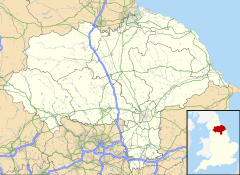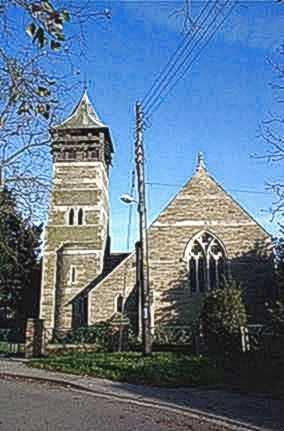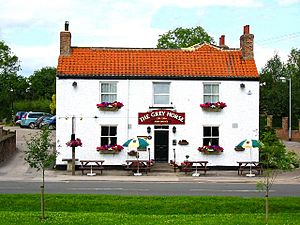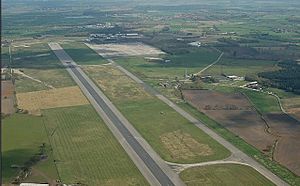Elvington, North Yorkshire facts for kids
Quick facts for kids Elvington |
|
|---|---|
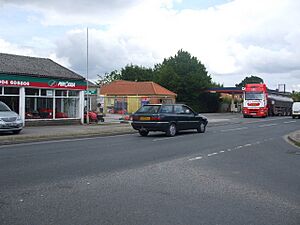 The B1228 Junction services |
|
| Population | 1,239 (2011 census) |
| OS grid reference | SE699476 |
| Civil parish |
|
| Unitary authority | |
| Ceremonial county | |
| Region | |
| Country | England |
| Sovereign state | United Kingdom |
| Post town | YORK |
| Postcode district | YO41 |
| Dialling code | 01904 |
| Police | North Yorkshire |
| Fire | North Yorkshire |
| Ambulance | Yorkshire |
| EU Parliament | Yorkshire and the Humber |
| UK Parliament |
|
Elvington is a village and civil parish located in the City of York, England. It's about 7 miles (11 km) south-east of the city of York, along the B1228 road that connects York to Howden. In 2011, about 1,239 people lived here.
The River Derwent flows near Elvington. The historic Sutton Bridge connects Elvington to Sutton upon Derwent. Elvington also has three large industrial areas. One of these is home to Yara International, a big chemical company from Norway.
Historically, Elvington was part of the East Riding of Yorkshire. Later, it became part of the Selby District in North Yorkshire from 1974 to 1996. Since 1996, it has been part of the City of York unitary authority, which means it's managed by a single local government.
Contents
Elvington's Past: A Journey Through Time
Elvington is an old village, even mentioned in the Domesday Book from 1086. This book recorded that the area had enough land for three ploughs. The village church, which is partly Norman in design, was also mentioned back then.
A powerful figure named Richard Neville, 16th Earl of Warwick, once controlled the land here. Elvington also has a special building called Elvington Hall. This hall was built during the time of Queen Elizabeth I. It was later updated in the 1700s by a famous architect named John Carr. The well-known writer Laurence Sterne even lived there for a part of his childhood.
How Elvington Changed in the 1900s
Between 1913 and 1926, a passenger train service ran through Elvington on the Derwent Valley Light Railway. This railway continued to carry goods until 1973.
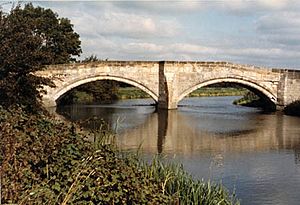
In 1942, during the Second World War, an airfield called RAF Elvington was built. It was used by planes during the war. The airfield closed in 1958. By 1986, parts of it became the Yorkshire Air Museum, which is now open to everyone. The airfield was also used for motorsports and airshows.
The author and screenwriter, Hugo Charteris, lived in Elvington. He passed away in the village in 1970.
Elvington Today: What's Happening?
In 1990, Elvington was made a "Conservation Area." This means its special historical and architectural character is protected.
The village has a pub called the Grey Horse Inn. You can also find a church, a shop, a primary school, and a sports field. Many groups and clubs meet in Elvington. These include drama clubs, Scouts, sewing groups, a youth group, and a toddler group.
Elvington is home to one of Britain's most unusual houses! In 2006, an old, unused bowling alley was turned into a private home. It still has a 55-foot (17 m) long bowling lane inside! The original bowling alley was built in the 1950s for American soldiers stationed at RAF Elvington. It was a popular spot for members of the Strategic Air Command.
Elvington is also where Rolawn is based. They are one of Europe's biggest companies that grow and supply turf (grass).
Elvington Harriers Football Club
The Elvington Harriers Football Club started in 1999. It's an FA Charter Standard Club, which means it meets high standards for how it's run.
The club has football teams for different age groups. These range from the 'Saturday Morning Club' for younger kids to teams for Under-7s all the way up to Under-15s. Each team wears the club's traditional yellow shirts and blue shorts. They play in the Selby District League. The home games are played in Elvington at the Lower Derwent Sports & Social Club. The club gets its money from player fees and special fundraising events.
Elvington Airfield: A Place of History and Speed
The Yorkshire Air Museum is located at Elvington Airfield. This airfield was once a bomber station during the Second World War. During the Cold War, the main runway was made even longer. It became one of the longest runways in Europe! This allowed huge American bombers, like the B52, to land there. The Yorkshire Airshow, which is the biggest airshow in the North of England, used to be held here every year. Now it happens every two years in August.
The airfield also has a race track. It's used for exciting events like drag racing and other motorsport activities. In November 1966, an Italian motor scooter rider named Alberto Ancillotti set a speed record of 106 mph (171 km/h) on his Lambretta bike at this very place.
Top Gear's Vampire Dragster Incident
On September 20, 2006, a TV show called Top Gear was filming at the airfield. During this filming, Richard Hammond was involved in an incident while driving a jet-powered car. He was going very fast, about 288 mph (463 km/h), when the car had an issue.
Images for kids


